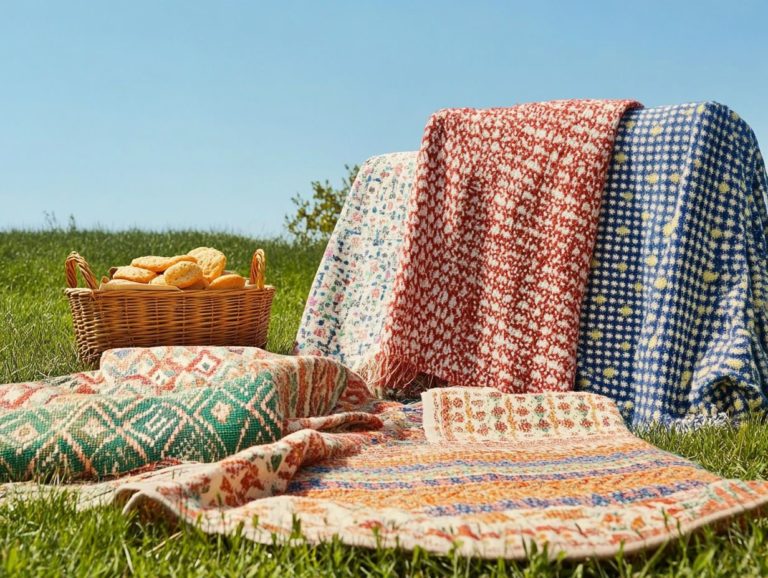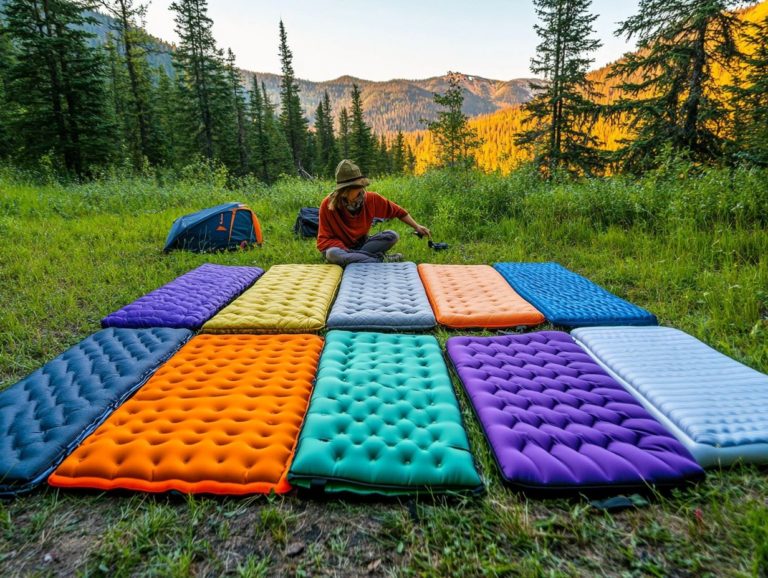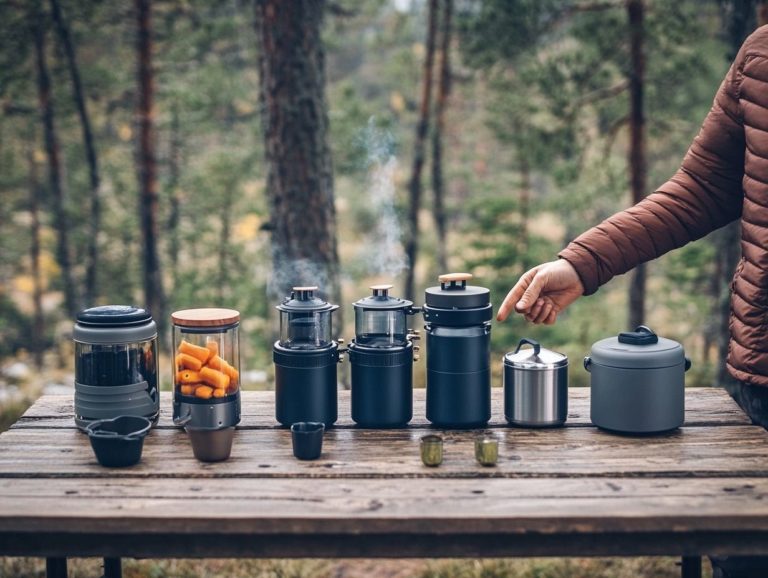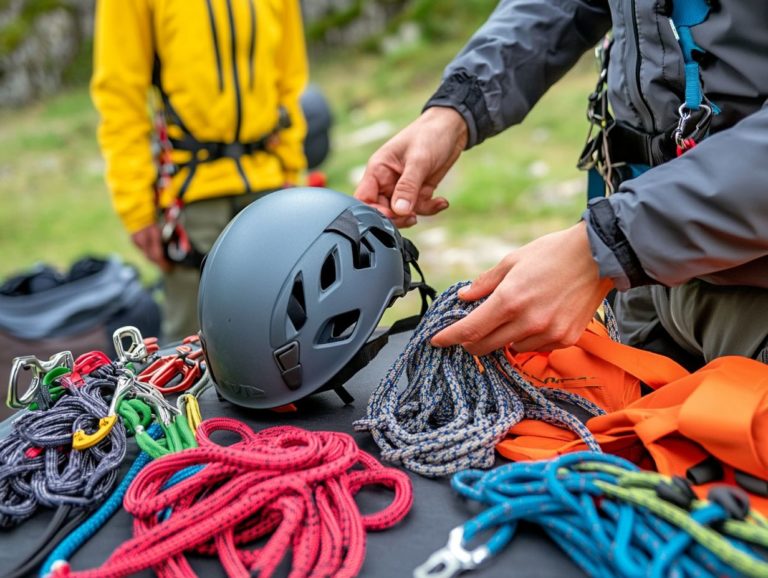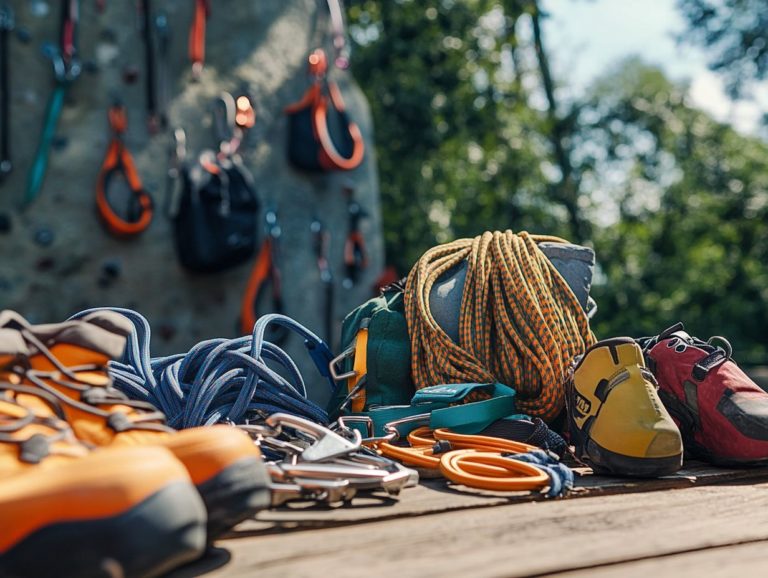What Types of Water Sports Equipment Exist?
Water sports present an exhilarating opportunity for you to connect with nature. To truly relish the experience, having the right gear is essential for activities like kayaking, surfing, and diving.
Whether you re surfing the waves, engaging in water polo, or gliding through the water in a kayak, each activity comes with its own distinct set of equipment designed to enhance your performance and safety. This article explores the various types of water sports gear available, from boards and paddles to essential safety equipment like wetsuits and life jackets. We ll cover both individual and team disciplines.
You ll find valuable insights on what to consider when selecting your gear, ensuring you’re thoroughly prepared for your next aquatic adventure in both competitive and recreational water activities.
Regardless of whether you re just starting out or are a seasoned enthusiast, understanding the basics will help you make informed choices and elevate your enjoyment of water sports. This enhances both your physical exertion and mental skills.
Contents
- Key Takeaways:
- Types of Water Sports Equipment
- Factors to Consider When Choosing Equipment
- Popular Water Sports and Their Required Equipment
- Frequently Asked Questions
- What Types of Water Sports Equipment Exist?
- What are Some Popular Types of Water Sports Equipment for Beginners?
- What is the Difference Between a Surfboard and a Bodyboard?
- What is the Most Essential Equipment for Snorkeling?
- What Types of Equipment are Needed for Water Skiing?
- Are There Any Advanced Water Sports Gear Available?
Key Takeaways:
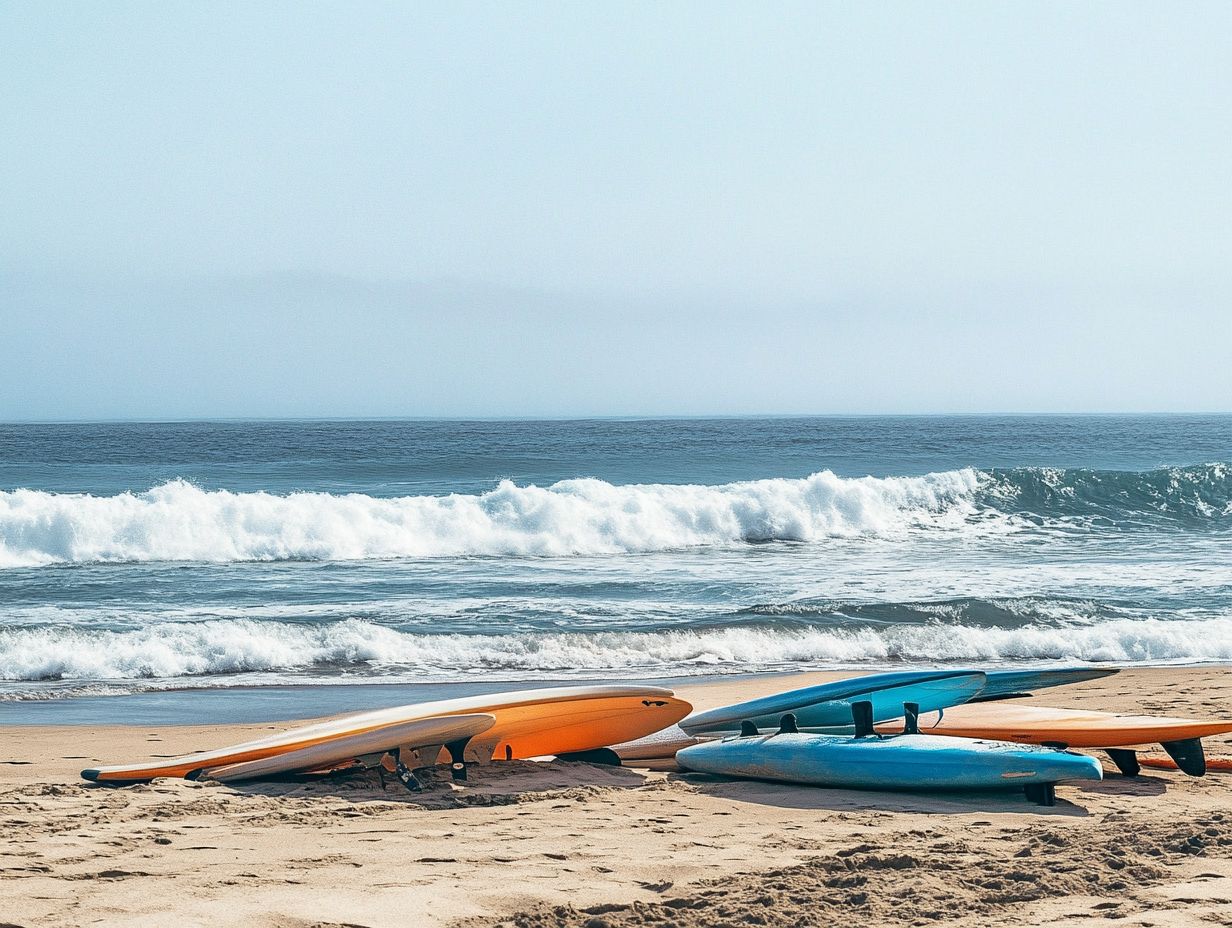
- Water sports equipment includes boards, paddles, sails, wetsuits, and more.
- When choosing equipment, consider skill level, water conditions, cost, and maintenance.
- Popular water sports like surfing, kayaking, stand-up paddleboarding, diving, and wakeboarding require specific equipment.
What are Water Sports?
Water sports include a variety of activities that take place on or in water, blending both competitive and recreational pursuits. These activities range from synchronized swimming to freediving and beyond. Whether you re kayaking, surfing, synchronized swimming, or diving, these endeavors promise exhilarating experiences and enhance your physical and mental capabilities.
Engaging in water sports offers numerous benefits, particularly for your physical health. You ll notice improvements in cardiovascular fitness which refers to how well your heart and lungs work strength, and flexibility as you participate in these activities.
In team-oriented sports like water polo, you ll also sharpen your communication and collaboration skills essential tools in any group setting.
Immersing yourself in water has a uniquely calming effect, helping to reduce stress and promote mental well-being. The role of governing bodies, such as FINA and the ICF, is crucial; they uphold safety protocols and ensure fair play, raising the standards of competitions.
These events challenge your individual abilities and foster a spirit of camaraderie and shared achievement, enriching your development as an athlete and strengthening the bonds within your sporting community.
Types of Water Sports Equipment
When you dive into water sports, having the right equipment is crucial for optimizing your performance, ensuring your safety, and amplifying your enjoyment across a range of activities.
The boards you choose for surfing or bodyboarding, the paddles and oars essential for kayaking and canoeing, are meticulously crafted for specific water adventures. Additionally, sails for sailing, wetsuits for diving or surfing, and life jackets for safety are important for both individual pursuits and team sports.
Boards
Boards are absolutely essential in a variety of water sports, from surfing to bodyboarding and stand-up paddleboarding. They offer you a platform to glide effortlessly across the water’s surface.
These boards come in an impressive array of designs, materials, and functionalities. Each is crafted to suit different skill levels and water conditions. Surfboards, for instance, are typically elongated and made from foam or fiberglass, perfectly engineered for wave riding. They demand both balance and agility from you.
Bodyboards, on the other hand, are shorter and often made from softer materials. They are designed to make navigating the waves while lying flat a breeze, making them perfect for beginners and enthusiasts alike.
Then there are stand-up paddleboards, which are wider and more stable. They boast a larger surface area and are usually made from inflatable PVC or foam. This makes them ideal for everything from serene lake paddling to tackling ocean surf.
Each type of board is tailored not just for specific recreational experiences but also captures the excitement of competition, giving you the power to perform at your absolute best.
Paddles and Oars
Paddles and oars are essential companions in water sports like kayaking and canoeing, giving you the power to glide effortlessly across the water.
Understanding the different types available, whether for kayaking, canoeing, or competitive swimming, can significantly elevate your experience. In kayaking, you ll typically wield a double-bladed paddle, designed for smooth, efficient strokes on both sides. Canoeing usually calls for a single-bladed oar, perfect for mastering unique steering techniques.
The materials of these tools vary widely from feather-light fiberglass and carbon fiber to robust wood and plastic. Each influences your performance and durability in distinct ways. As you refine your skills or encounter varying water conditions, choosing the right paddle or oar becomes essential for your comfort and safety during your aquatic adventures.
Sails
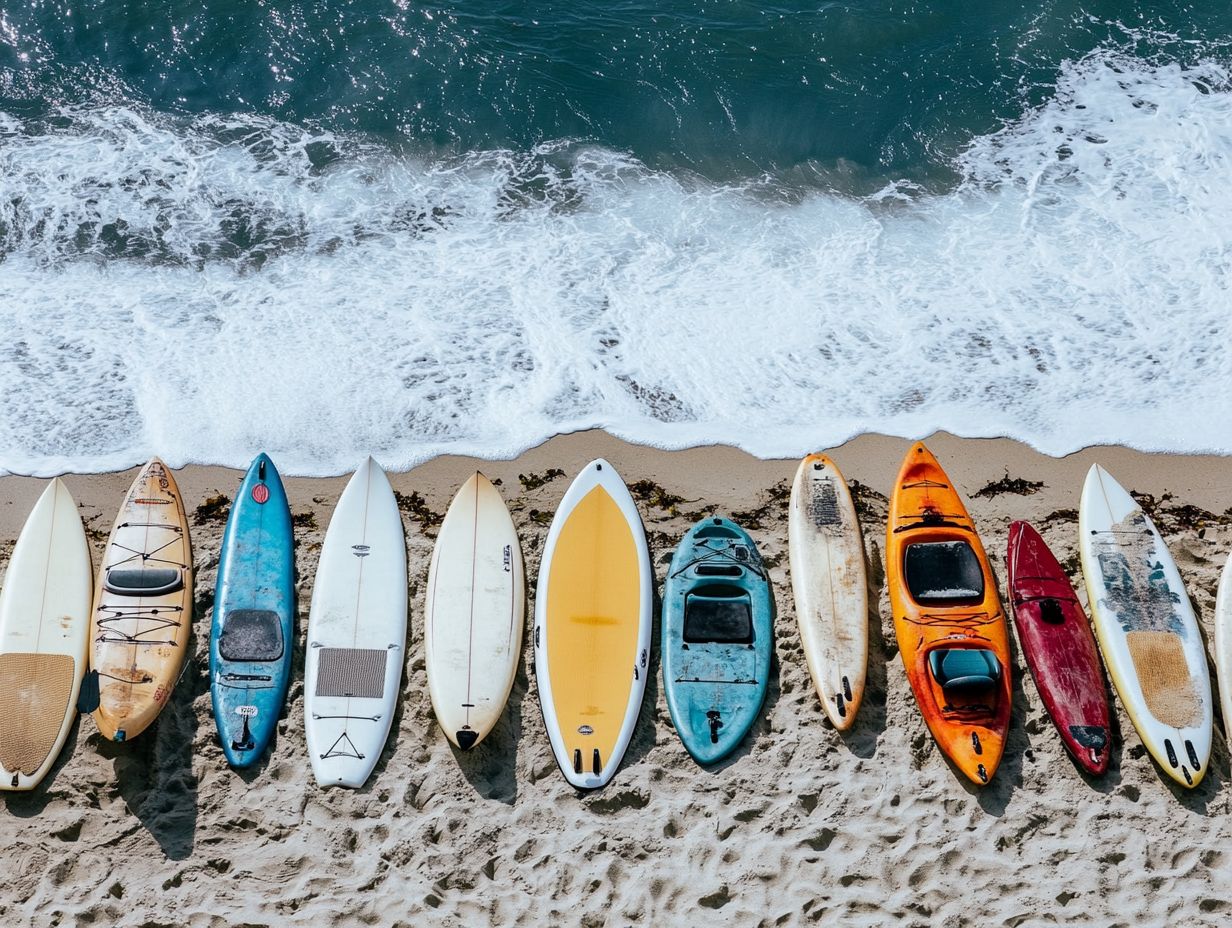
Sails are a fundamental aspect of sailing and various water sports that harness the power of the wind. They play a crucial role in performance and maneuverability on the water.
Different types of sails vary significantly, with materials ranging from durable polyester to advanced carbon fiber. Each is chosen for its unique properties. Sizes can differ greatly as well, from small, nimble sails designed for high-speed racing to expansive ones crafted for leisurely cruising.
The purpose of the sail goes beyond catching the wind; it s about using it effectively. You must consider how wind conditions, including direction and speed, can dramatically influence a vessel’s performance. Understanding how to select the right sail for various water activities becomes essential, as a poorly matched sail can jeopardize both speed and control.
Wetsuits and Life Jackets
Wetsuits and life jackets are essential safety gear in a variety of water sports. They offer both insulation and buoyancy for those engaged in activities like diving and swimming.
These critical pieces of equipment come in multiple types, each tailored for specific water conditions and individual needs, ensuring safety in all forms of water sports.
- Wetsuits are your ticket to thrilling adventures in cold waters! They are typically made from neoprene (a type of rubber), which traps a layer of water against your skin, warming it with your body heat. They re perfect for surfing, wakeboarding, or diving in colder waters.
- Life jackets are made from materials such as polyethylene foam or inflatable fabrics. They deliver optimal buoyancy whether you re kayaking or sailing.
Donning the right safety gear not only boosts your performance but also instills confidence. This allows you to push your limits with the assurance that your protection is firmly in place, especially in high-risk water activities like canyoning and jetboarding.
Other Essential Gear
Along with boards, paddles, and wetsuits, there’s a whole range of essential gear and accessories that can elevate your experience in water sports. These items not only ensure your safety but also enhance your performance.
Helmets are essential when you re kayaking or surfing. They provide crucial protection against unexpected falls or collisions that could ruin your day. Then there are snorkels, which allow you to take in breathtaking underwater wonders without needing to constantly resurface for air.
Fins are another game-changer, offering improved propulsion with less effort especially important during those long swims. Don t overlook safety kits; they re packed with essential tools like first aid supplies, signaling devices, and flotation aids. These ensure a safer environment whether you re paddleboarding, diving, or surfing.
Each of these accessories boosts your safety and enhances your overall enjoyment and confidence as you engage with the water.
Factors to Consider When Choosing Equipment
Choosing the right equipment for water sports requires careful attention to several key factors. Think about your skill level, the specific water conditions you’ll encounter, the cost, and the maintenance needs of the gear.
This thoughtful approach ensures not only your safety but also allows for best performance on the water.
Skill Level and Water Conditions
Understanding your skill level and the water conditions is crucial when selecting equipment. These elements directly impact the type of gear that will enhance your water sports experience.
As a beginner, you ll benefit from more stable and forgiving gear. Think wider paddleboards with softer edges or kayaks specifically designed for stability. Both facilitate easier balancing and maneuvering.
If you re an advanced practitioner, you likely seek equipment that elevates your performance. This could mean opting for narrower, more agile boards for surfing or sophisticated kite setups, which allow for greater control in challenging waters.
The water conditions, like choppy waves or strong currents, greatly influence your gear choices. A sturdier surfboard with a thicker design is ideal for maintaining stability in rough seas, while a lightweight option may serve you better in calmer waters.
Cost and Maintenance
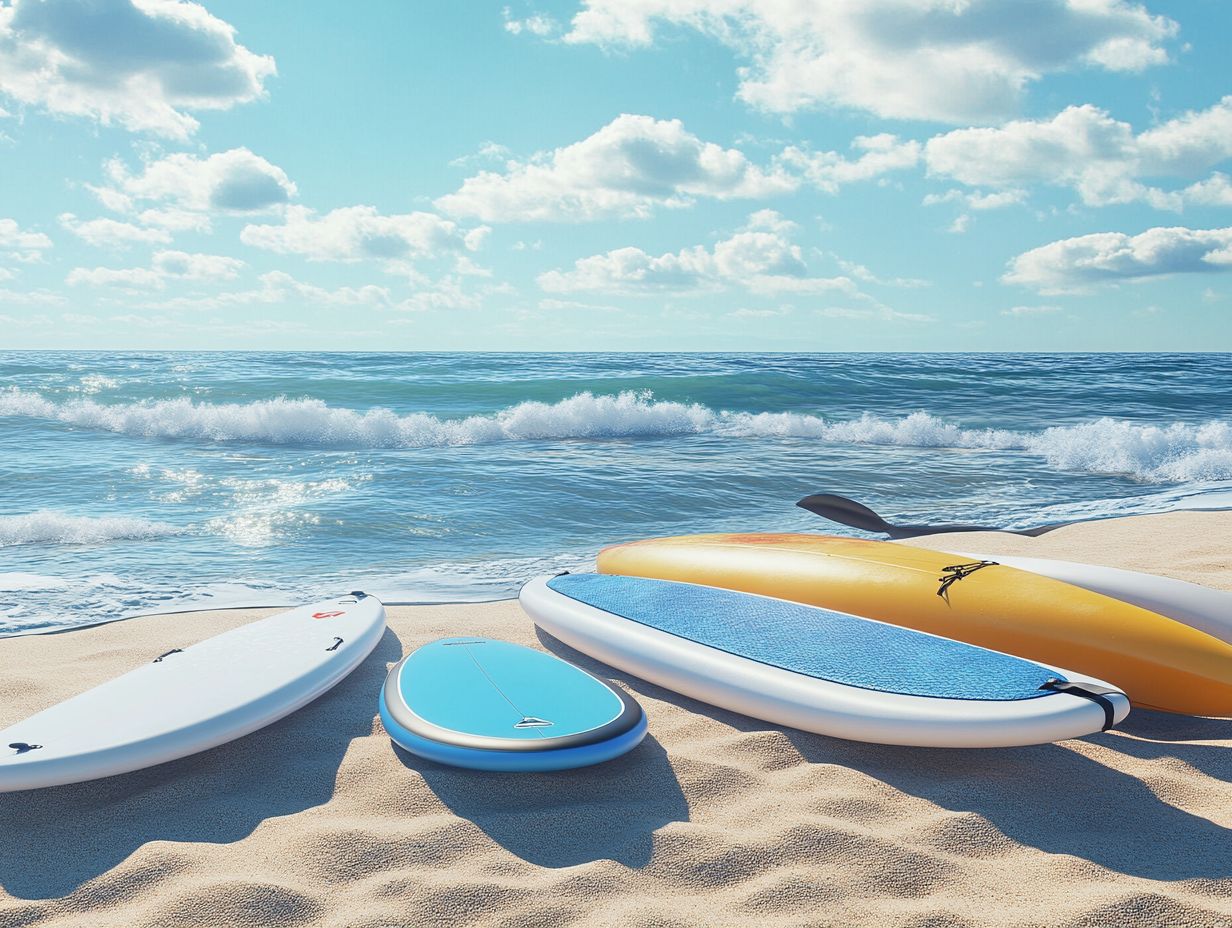
Cost and maintenance are essential factors when selecting equipment for your water sports endeavors. They influence both your initial investment and the long-term usability of your gear.
Striking the right balance between quality and affordability can be quite the challenge, yet it s crucial for ensuring you have an enjoyable experience on the water. As a water sports enthusiast, you may find yourself at a crossroads: should you invest in high-end products that promise durability and exceptional performance, or lean towards budget-friendly options that might carry risks?
Regular maintenance is key to protecting your investment. Simple practices, like rinsing off saltwater after each use and storing your gear in a cool, dry place, can significantly extend its lifespan. This not only enhances safety but also ensures reliability during every adventure you embark on.
Popular Water Sports and Their Required Equipment
Engaging in popular water sports such as surfing, kayaking, and stand-up paddleboarding necessitates the use of specialized equipment. This gear is meticulously designed to elevate your experience and optimize your performance on the water.
Each activity calls for its own unique gear, ensuring that you make the most of every wave, paddle stroke, and glide.
Ready to gear up? Get the right equipment and dive into your next water adventure today!
Surfing
Surfing is an exhilarating water sport that invites you to ride the waves on a specially designed board. Your choice of equipment is vital for both performance and safety.
A longer, wider board can give you the stability you need to feel confident as a beginner. Experienced surfers often choose shorter, more agile boards that enable sharper turns and impressive tricks.
Your wetsuit is also important. It provides insulation and protection from the elements. Materials like neoprene, a flexible material used for wetsuits, help retain your body heat while granting you the flexibility and freedom of movement essential for navigating the water effectively.
Together, these essential pieces of gear empower you to confront the unique challenges posed by various wave conditions, ensuring a safer and more enjoyable surfing experience.
Kayaking
Kayaking is all about navigating waterways with a kayak and paddles. It requires specific equipment to ensure both safety and optimal performance on the water.
Choosing the right type of kayak be it a sit-on-top, touring, or inflatable can elevate your experience, especially in varying conditions. A touring kayak is your best bet for long journeys, while a sit-on-top excels in warmer, shallower waters.
Don t forget about paddles; they come in various lengths and materials, affecting your efficiency and comfort with each stroke. Your safety gear is equally essential. Life jackets and helmets provide peace of mind, allowing you to immerse yourself in the beauty of your surroundings without worry.
Prioritize these elements and don t wait! Grab your gear and set out on a kayaking adventure today!
Stand-Up Paddleboarding
Stand-up paddleboarding (SUP) is a vibrant water sport that seamlessly blends balance, fitness, and fun. It requires specific boards and paddles designed for optimal stability and performance.
Choosing the right equipment is essential. The various types of boards cater to different activities, whether you re enjoying a leisurely paddle on a serene lake or tackling the challenges of the open ocean. Beginners often find wider, more stable boards to be their best allies, offering the balance needed to feel confident on the water.
As you progress, those narrower, faster boards may start to beckon, enhancing your control and performance. Paddles also come in various options, adjustable in length and made from materials like aluminum or carbon fiber. Choose what feels comfortable and efficient for you.
Always consider your personal skill level and the water conditions to ensure an enjoyable experience on your paddleboarding adventure.
Frequently Asked Questions
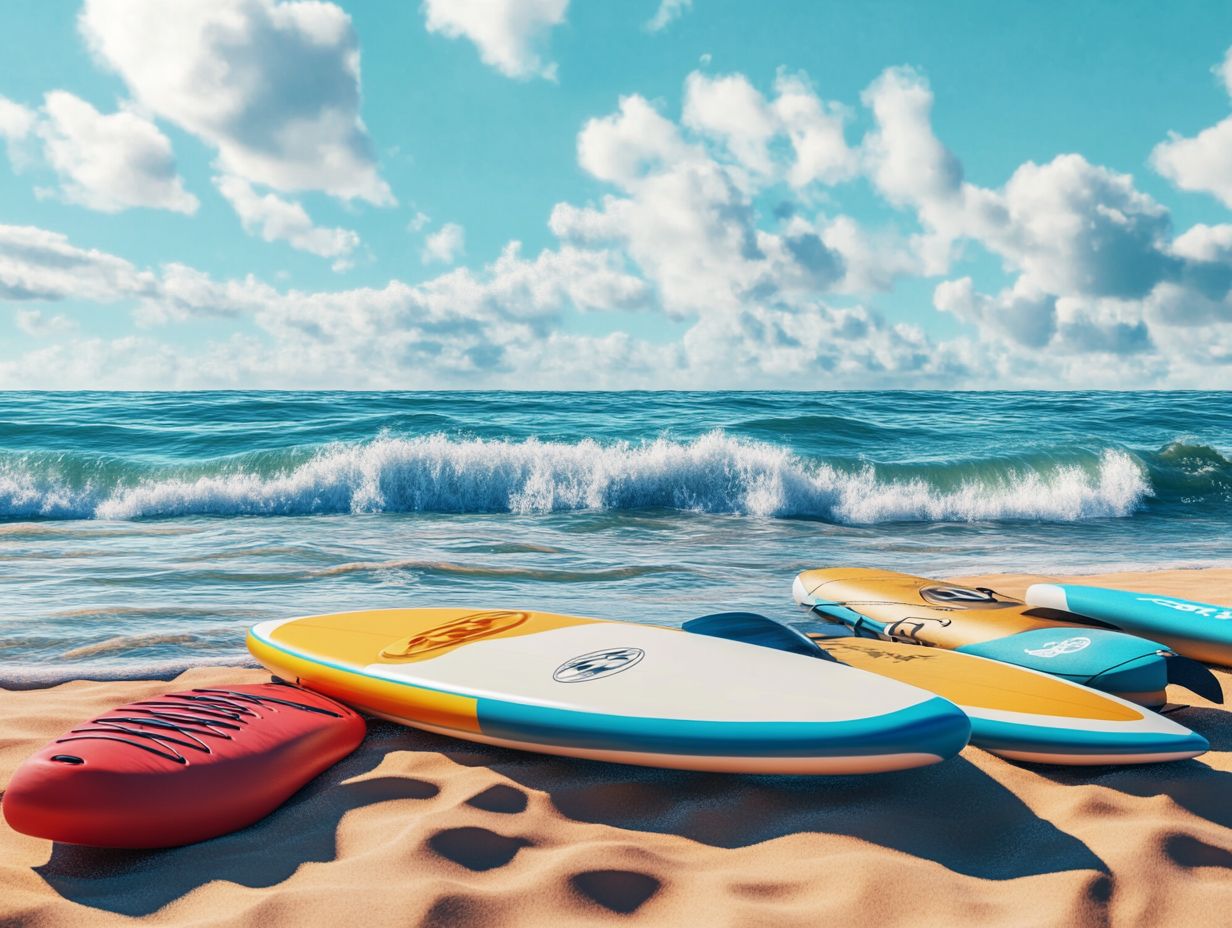
What Types of Water Sports Equipment Exist?
Numerous types of water sports equipment exist, catering to a wide range of activities and skill levels. These include gear for surfing, snorkeling, kayaking, paddleboarding, and water skiing, among others.
What are Some Popular Types of Water Sports Equipment for Beginners?
For beginners, popular types of water sports equipment include bodyboards, inflatable rafts, and beginner-friendly kayaks or paddleboards. These options are typically easier to use and require less skill or experience.
What is the Difference Between a Surfboard and a Bodyboard?
A surfboard is typically longer and narrower than a bodyboard and is used for riding waves in a standing position. A bodyboard, on the other hand, is shorter and wider, used for riding waves while lying down on the board.
What is the Most Essential Equipment for Snorkeling?
The most essential equipment for snorkeling includes a snorkel mask, fins, and a snorkel tube. These allow you to see and breathe underwater while exploring the ocean’s beauty.
What Types of Equipment are Needed for Water Skiing?
To water ski, you’ll need a ski boat, water skis, and a tow rope.
Don’t forget a life jacket, wetsuit, and ski handle for better grip!
Are There Any Advanced Water Sports Gear Available?
Yes! There are advanced water sports gear like electric surfboards, motorized snorkels, and underwater scooters.
These exciting tools can elevate your water sports experience!

